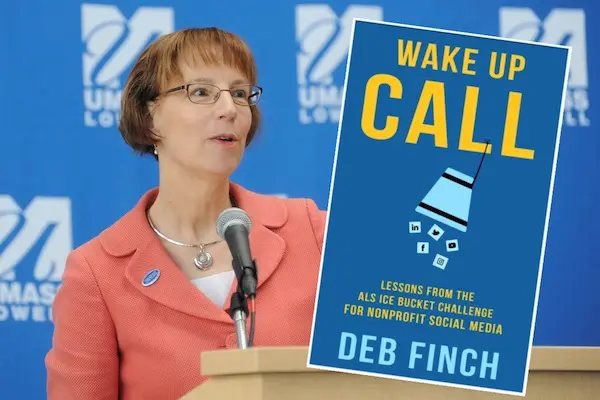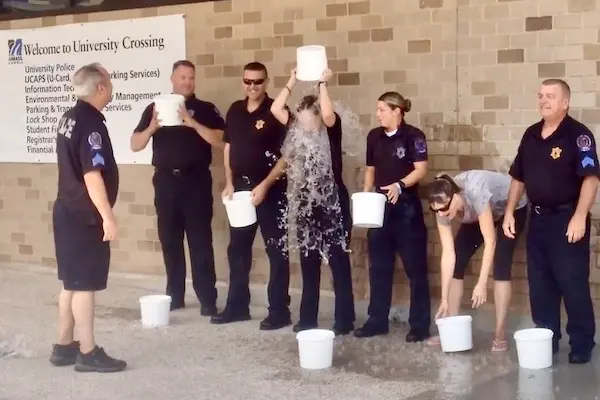Manning School’s Deb Finch Offers Social Media Tips to Nonprofits
 Image by Tory Wesnofske
Image by Tory Wesnofske
In her new book "Wake Up Call: Lessons from the ALS Ice Bucket Challenge for Nonprofit Social Media," Manning School of Business Assoc. Teaching Prof. Deb Finch says more posts is not a strategy.
12/15/2020
By Ed Brennen
“I wanted a common read for my Marketing for Nonprofits class that would interest students,” says Finch, whose search results for such a book on Amazon came up empty each year.
So this year, Finch decided to write one of her own: the recently published “Wake Up Call: Lessons from the ALS Ice Bucket Challenge for Nonprofit Social Media.” It was a project for a class she took on demonstrating expertise through book writing — a course she wants to bring to UMass Lowell.
“I’ve seen how smaller nonprofits struggle to effectively utilize social media and I want to help them improve,” says Finch, director emeritus for the Lowell Association for the Blind. “The book also speaks to students who are looking at nonprofit marketing and a career in nonprofits for the first time.”
Recipient of the 2018 Manning Prize for Excellence in Teaching, Finch is donating all proceeds from the book to Compassionate Care ALS in Falmouth, Massachusetts, which provides services, funds and equipment for those with the nervous system disease.
“I also want to be able to give it to my students for free to read. That was important to me,” says Finch, who has been actively involved in the university’s efforts to lower textbook costs for students.
Among the 20 people Finch interviewed for her book are Lorna Boucher ’86, chief marketing officer at Instinet and Manning advisory board member, UML’s Social Media Manager, Colleen Gordon ’20, and Asst. Profs. of Marketing Spencer Ross and Mark Yim.
Finch, who is a mentor for business students in the Honors College and a faculty fellow for the DifferenceMaker program, spoke by phone recently about writing her first book, how nonprofits can best leverage social media — and whether there will ever be a viral rival to the Ice Bucket Challenge.

Members of the UMass Lowell Police Department participate in the ALS Ice Bucket Challenge in August 2014 after being challenged by the UMass Boston Police.
Q. How did the book take shape?
A. It started in January when I attended a national entrepreneurship education conference. I met Eric Koester, a professor from Georgetown University who started a course called the Creator Institute, where he coaches students through five months of book writing. I thought our Honors College students would love something like this, so I started thinking about how I could bring the course to UMass Lowell. Then I realized: I should probably take the course before I try to teach it.
Q. You were able to publish your book in under a year. Safe to say the course was a success?
A. It’s very well done. What I like about it is, it’s more than writing a book. You meet weekly with editors and you’re part of a cohort of about 35 students, so you have a support network of people cheering you on. But it’s also about the entrepreneurial process. You run an Indiegogo campaign to raise money to cover the cost of printing, and I was fortunate to raise over $8,000. I learned so much about how to run an online fundraising campaign that will be helpful for our DifferenceMaker students.
Q. Why was the ALS Ice Bucket Challenge so successful?
A. Pete Frates really got it going, but it wasn’t a brand new idea that he came up with. There was already something called the Cold Water Challenge. But he’s the first person to tie it to ALS. And it really took off because he understood social media. The sharing part — calling out three people — that was genius. That’s how it grows exponentially. I had the privilege of speaking with two senior vice presidents from the ALS Foundation, Brian Frederick and Carrie Munk, and learned how they were handling it on the back end. They were very transparent about how much money they were raising, posting every day to keep it moving forward.
Q. How is social media marketing for nonprofits different than for a company like Starbucks or Tesla?
A. The biggest challenges for nonprofits are staffing and resources. I focused on smaller nonprofits with budgets under $500,000 that don’t have a full-time marketing person on staff. When you don’t have a full-time social media person, it’s done piecemeal and becomes very hard. I encourage nonprofits to assign someone to social media — and not necessarily the youngest person you have on your staff, which is what tends to happen. Doing social media for a nonprofit is quite different than your own personal social media. It’s part of a marketing strategy for a nonprofit and it needs to align with what you’re trying to do.
Q. What advice would you offer to nonprofits to improve their social media presence?
A. One thing I hear over and over from students that were working with nonprofits, maybe as an Honors project, is ‘What do you want your social media to do?’ Even executive directors of organizations will say, ‘We just need more posts.’ But more posts is not a strategy. What do you want those new posts to do? Are you trying to get new donors? Are you looking for volunteers? Are you trying to educate and inform? One thing I find lacking with nonprofits is an action plan. Develop a content calendar and have somebody who sits down every two or three weeks and maps out what your social media is going to look like on platforms like Facebook, Instagram, Twitter and LinkedIn. It can be overwhelming for a nonprofit, but there’s a way to simplify it.
Q. Are there examples of local nonprofits that do a good job on social media?
A. The Boys and Girls Club of Greater Lowell does a fantastic job. It’s probably my primary go-to if I want to look at an organization. Their stuff is well-formulated, and one of our graduates from the Manning School, Lindsey Andella (’18), was doing their social media prior to the pandemic. The Greater Lowell Chamber of Commerce also does an excellent job. They’re always running polls and asking questions. They engage really well, which is another area where nonprofits lapse. If somebody likes your post or posts a comment, ideally you’re responding or thanking them within a few hours. That’s part of the success of the Ice Bucket Challenge — the ALS Association made sure they were quickly responding and thanking people.
Q. Will there ever be another social media phenomenon like the Ice Bucket Challenge?
A. Honestly, until this summer, I would have said no. But the Minnesota Freedom Fund, a nonprofit working to eliminate cash bail, raised $30 million this summer after the killing of George Floyd. People wanted to do something by writing a check, and the fund started getting donations from all over the country after people started sharing their organization on social media. I think that will be a very good case study in a few years.
